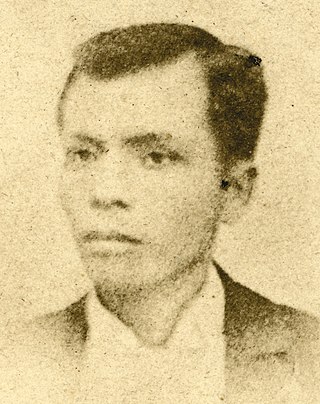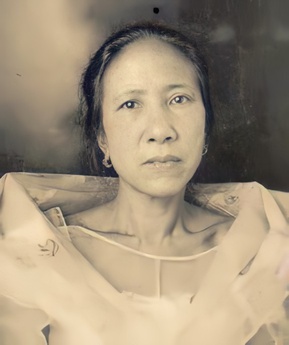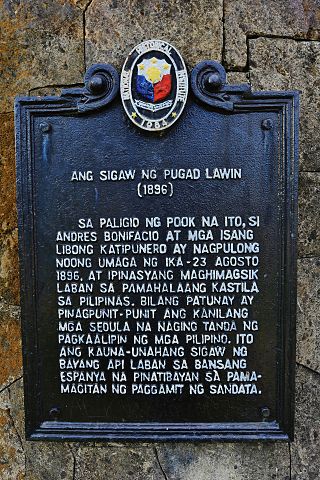
The Katipunan, officially the Kataastaasan Kagalang-galang na Katipunan ng mga Anak ng Bayan(lit. 'Supreme and Honorable Association of the Children of the Nation'; Spanish: Suprema y Honorable Asociación de los Hijos del Pueblo) and abbreviated as the KKK, was a revolutionary organization founded in 1892 by a group of Filipino nationalists Deodato Arellano, Andrés Bonifacio, Valentin Diaz, Ladislao Diwa, José Dizon, and Teodoro Plata. Its primary objective was achieving independence from the Spanish Empire through an armed revolution. It was formed as a secret society before its eventual discovery by Spanish authorities in August 1896. This discovery led to the start of the Philippine Revolution.

Andrés Bonifacio y de Castro was a Filipino revolutionary leader. He is often called "The Father of the Philippine Revolution", and considered one of the national heroes of the Philippines.

San Juan, officially the City of San Juan, is a 1st class highly urbanized city in the National Capital Region of the Philippines. According to the 2020 census, it has a population of 126,347 people. It is geographically located at Metro Manila's approximate center and is also the country's smallest city in terms of land area.

The Philippine Revolution was a war of independence waged by the revolutionary organization Katipunan against Spain from 1896 to 1898. It was the culmination of the 333-year colonial rule of Spain to the archipelago. The Philippines were among the last colonies of the Spanish Empire, which saw a massive decline particularly in the 1890s. Cuba rebelled in 1895, and the empire soon fought against the United States in a war that they lost. In June 1898, Philippine revolutionaries declared independence. However, this was not recognized by Spain, which sold the islands to the United States in the Treaty of Paris.

Pinaglabanan Memorial Shrine is a Filipino national shrine and park along Pinaglabanan Street in the city of San Juan, Metro Manila, Philippines. This was built to commemorate the heroism of the Katipuneros who laid siege to Almacen de Polvorín, an armoury belonging to the Spanish Colonial Government, becoming the first battle of the Philippine Revolution against the Spanish Empire.

The Thirteen Martyrs of Cavite were Filipino patriots in Cavite, Philippines who were executed by musketry on September 12, 1896, for cooperating with the Katipunan during the Philippine Revolution against Spain. The de facto capital city of Trece Martires in Cavite is named after them.

Ladislao Diwa y Nocon was a Filipino patriot who was among the founders of the Katipunan that initiated the Philippine Revolution against Spain in 1896.

The Tejeros Convention, also known as the Tejeros Assembly and the Tejeros Congress, was a meeting held on March 22, 1897, between Katipunan factions of Magdiwang and Magdalo in San Francisco de Malabon, Cavite that resulted in the creation of a new revolutionary government that took charge of the Philippine Revolution, replacing the Katipunan. It followed on a previous meeting now known as the Imus Assembly. Filipino historians consider the first presidential and vice presidential elections in Philippine history to have been held at this convention, although only Katipuneros were able to take part, and not the general populace.

Gregoria de Jesús y Álvarez, also known by her nickname Oriang, was the founder and vice-president of the women's chapter of the Katipunan of the Philippines. She was also the custodian of the documents and seal of the Katipunan. She married Andrés Bonifacio, the Supremo of the Katipunan and President of the Katagalugan Revolutionary Government. She played a major role in the Philippine Revolution. After the death of Bonifacio, she married Julio Nakpil, one of the generals of the revolution. She had one son from Andrés Bonifacio and five children from Julio Nakpil.
General Aquilino Tiburcio de León y Gregorio Tolomeo was a Filipino freedom fighter who was a general during the 1896 Philippine Revolution and the Philippine–American War. He first served under Andrés Bonifacio in the Katipunan, and then, reluctantly, under the revolutionary government formed by Emilio Aguinaldo.

The Cry of Pugad Lawin was the beginning of the Philippine Revolution against the Spanish Empire.
Daniel Tirona y Tria was a Filipino politician. He became infamous for causing divisions within the Philippine revolutionary movement and for insulting and maligning Andres Bonifacio during the Tejeros Convention in 1897.

The Battle of Binakayan–Dalahican was a simultaneous battle during the Philippine Revolution that was fought on November 9–11, 1896 that led to a decisive Filipino victory. The twin battle took place at the shores of Binakayan, in the town of Cavite Viejo ; Dalahican and Dagatan in Noveleta; and, to minimal extent, in Imus and Bacoor towns in Cavite, Philippines that lasted for two days before the Spanish army retreated demoralized and in disarray. The result of the battle was the first significant Filipino victory in the country's history.
1896 in the Philippines details events of note that happened in the Philippines in the year 1896.

The Battle of Pasong Tamo was a series of short skirmishes shortly after the Cry of Balintawak between the remaining Katipuneros in Caloocan and the Guardia Civil.

The Battle of Kakarong de Sili was fought on January 1, 1897, at Pandi, Bulacan, in the Philippines. The Kakarong Republic, based in the little fort in Pandi, was attacked by a force of Spaniards who massacred the Katipuneros there. At the end of the battle, General Eusebio Roque was captured by the Spaniards. The Kakarong republic was considered the first republic formed in Bulacan and in the Philippines.
The Battle of San Mateo and Montalban was a battle fought between the remaining Katipuneros under the command of Andres Bonifacio and Emilio Jacinto and the Spanish government after a failed attempt to capture the El Deposito water works at San Juan del Monte.

The Battle of Manila of 1896 occurred in Manila in the Spanish colony of the Philippines during the Philippine Revolution. Katipunan under Andres Bonifacio attempted to take the city but the attempt failed, and Bonifacio retreated to the city's outskirts. The Battle of San Juan del Monte was joined a day later when Bonifacio attempted to capture the San Juan's powder magazine, but this too failed.
This is the timeline of the El Filibusterismo . It contains details before and after public of El Filibusterismo.

Museo ng Katipunan is a history museum in the city of San Juan in Metro Manila, Philippines dedicated to the Katipunan. It is situated within the grounds of the Pinaglabanan Shrine.



















